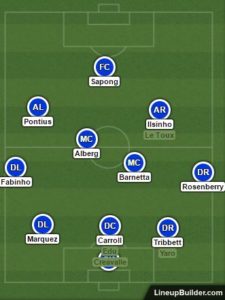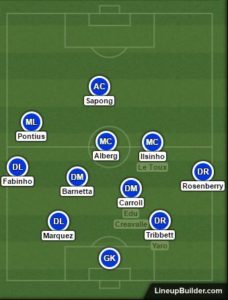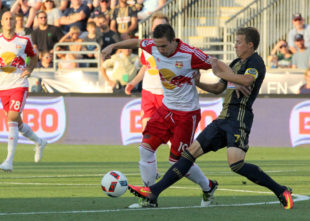Photo: Paul Rudderow
PSP commenter Jim Presti graciously slogged through my player ratings piece following Philadelphia Union’s 2-2 draw with New York Red Bulls and asked a question I hadn’t addressed.
For the first hour of the match, New York had the Union on the ropes for the second straight match. Even though the Union came back each time, those comebacks were not inevitable. So: What could Jim Curtin and Earnie Stewart do to counteract the approach Jesse Marsch has somewhat successfully taken against them?
As I said in the comments of the ratings piece, I think it’s important to note that it’s unlikely there is a large group of MLS teams capable of pulling off the sort of manic pressure and organized high line that the Red Bulls used so effectively on Sunday. That style of play sucker punched most of the Eastern Conference (and a lot of the West, too) last season, and even if it has been less dominant this go-around, it still has New York firmly ensconced among the top tier of the east.
But even if the methods the Red Bulls employed are difficult to ape, the outcome may be achievable by other means. Marsch wanted to collapse space in the Union’s half, with a particular emphasis on preventing the wingers and CJ Sapong from acting as outlets that could then bring the midfield into play. To this end, Sapong was marked tightly by two center backs who played quite close to each other, and Ilsinho and Pontius would’ve had more room to operate if they set up shop in my old studio apartment in downtown Philly.

With the DM deep, Philly can buy time to play in the back line, but it’s difficult to buy time for the fullbacks on the ball, and there is a tendency to look long because midfield numbers are rarely in your favor.
The Union’s solution was to go long to Chris Pontius. This was successful to the extent that it occasionally relieved pressure, but it led to a grand total of three shots within 30 yards of goal prior to the penalty that changed the momentum of the match. A creative coach on a team that can afford to take risks (coughPaunoviccough) might see New York’s success and wonder if he could cloud the midfield with a 3-5-2 shape, risking a 1v1 battle with Sapong in hopes of keeping Barnetta and Alberg off the ball. Another might wonder if situationally man-marking Barnetta inside of a high pressure system would make the Union a far less fluid team.
Returning to the question though: What can the Union do to make sure they don’t spend the second half of the season (and potentially the playoffs) fighting this one opposition approach in different forms?
A defensive midfielder with elite passing range?
Jim suggested a defensive midfielder with more range, and that is certainly one potentially viable solution. It’s very possible that Marsch would have been more hesitant to play a Guardiola-esque line if someone other than Brian Carroll was sitting between the center backs. Ironic, then, that Carroll unleashed some of the best long passes of the season on New York.
But finding a defensive midfielder who can pass like that is surprisingly difficult. The Red Bulls have Dax McCarty. Columbus boasts Wil Trapp. Toronto and NYC both spent big to bring in players with such a skill set.
Though you could argue for a longer list, I doubt there’s much consensus beyond that group in terms of deeper lying midfielders who can pick out long, accurate passes under the time constraints New York tried to impose on Sunday.

Putting numbers in midfield exposes the team to more risk – a press is built to win the ball in that own-half midfield zone. But getting the ball into the middle offers benefits like freeing up the fullbacks and creating wide zones for Sapong to collect the ball if it goes long.
A more compact midfield
Another potential tactical response, and the one I currently lean toward (though my mind can be changed!) is to work on building a more compact, quick-passing midfield to move through pressure.
This might mean pulling Roland Alberg deeper during buildups and asking one of the wingers to tuck into a channel as an option that breaks multiple lines. It might mean more passes close to goal, which introduces an elevated level of danger. It probably means CJ Sapong has to get better at varying his runs between checking back and cutting toward sidelines at an angle.
In short, it’s not nearly as easy as introducing a defensive midfielder who can pass around a press.
However, it might be easier than scouting, seducing, and paying that player. And the long-term benefits may be greater.
There are certainly more potential solutions to the problems Jesse Marsch has posed over the last 180 minutes of extremely satisfying and exciting Red Bull-Union action. The Union may benefit from tucking Keegan Rosenberry inside during buildups, going to more of a temporary back three look recognizing that the wing is a trapping area and Rosenberry can both spread the field and protect the ball in tight spaces. Alternatively, they could try to stretch the field with Sebastien Le Toux, though that still requires finding a way to create space so hitting long passes doesn’t require Brian Carroll to find the sweet spot on his left foot every game. Finally, there’s always the chance that Joshua Yaro proves to be a high press killer with his calmness on the ball and accuracy going long, but my suspicion is that Jesse Marsch would’ve bet heavily on Yaro making a similar mistake to the one Ken Tribbett made on Sunday.
Feel free to lay out your ideas in the comments below, but remember that there are no inherently wrong or right answers, just tactical strategies borne from different theoretical assumptions about what players are capable of and how a team should organize and play on the field. In other words: Retain the unspoken rule of PSP: There are no dumb takes (except “Bring back Nowak”).


Just in time for Mr. Mo Edu to make his re-entry…CDM who can ping long passes accurately. Ding, Ding.
I think that really prompts one of the big questions we’ve been asking all year: Can Mo slide in and do exactly this? And if so, when?
.
I’d wager not to the extent we need. He likes the forward run more than he does to drop deep and ping passes. If Curtin can work that into Edu’s game, he certainly has the ability to do so but we’re going to need an alternate to just Mo.
He did the accurate long passing thing as a center back, for certain. Gaddis and White in particular always fed him rather trying to distribute themselves.
From Curtin’s description in a recent press conference I would say he’s at least a month to get to anything approaching meaningful game minutes. It’s two to three weeks from 15 to 90 the way they time the sequence in preseason, and that assumes no setbacks for soreness, et al.
My honest hope is that this injury has caused him to sit back look at this team from a new perspective and see exactly where his role is. That way, we will not see him over-playing and trying to do too much once he is back on the field.
I’ve got to believe that our number 2 and 3 picks are the solution here. Rosenberry is among the top 5 distributors on the team right now I think (and you could talk me into top 3). With that in mind, allowing him to see lots of the ball in the buildup could separate the defensive lines and give barnetta the space he needs to turn and head forward. Yaro also has a superior passing range. See the goal in our first game against DC if you need evidence.
Tough to read why Tribett has been starting recently. He has two consecutive games with some noticeable mistakes in the back.
.
If he keeps starting, I would begin to suspect that they are choosing to protect Yaro’s shoulder.
.
This crazy thought has just popped into my head and has less than a 1% chance of having any worth. Nonetheless, they may have sought the opportunity for Daly to play in NASL for a month to see whether he rises to the level, looking for backup to Tribbett if Yaro needs season-ending surgery. It would be the thriftiest option. Game time may be sufficiently different from practice at the professional level that practice doesn’t tell them what they need to know.
The loan has a buy option so is likely not about just getting a look.
Yaro has made his share of errors too, (vancouver comes to mind, Houston wasn’t exactly a shining beacon either). I’d suspect this is match-up related. Speedy teams get yaro, big teams tribbet, possibly even home and away variance. But they have both shown a willingness to step into the midfield when BC retreats between the center backs. what we need is better decisions once they’ve decided to push (read: short ball to quillo, alberg or rosenberry, long to the wings, recycle play, or hoof and hope to sapong in the last ditch.)
As I look at the upper line-up builder slide I REALLY do not like the alignment, not because of its impact on the problem Adam Cann is discussing, but for another reason entirely. BC’s speed and size.
.
You have a player against whom it is possible to achieve 1 1/2 yards of separation in less than 10 yards of contact playing in the center of three flat defenders. AND you tend to want to play compactly when in possession exposing lots of space behind your defense. BC is one of the worst choices on the team to defend long, high, direct service into space in the central channel.
.
A fully fit, in-form Maurice Edu could defend adequately in the scheme as drawn. It asks more of BC than he can give these days.
I think that your idea of tucking Rosenberry inside further helps relieve pressure. He’s comfortable on the ball in tight spaces and has great range of passing with either foot. Either Alberg or Ilsinho will have to provide a wide option on the right side, but my preference would be to pull Sapong out wide further up the pitch and force a center back to follow which will create an advantage in isolating the remaining center back and d-mid vs the Union central players. Plus, if the attack goes down the right, the remaining center back really has to be aware of Pontius coming central, especially in a aerial situation. He’s just too much for a fullback to handle when he gets into the box.
Part of it is situational awareness. When the defenders are being pressured, they need to get rid of the ball quicker and/or back each other up. It may cost in possession, but it is safer and will sometimes lead to a quick counter (assuming the offense can stay onside).
.
Likewise, Ilsinho and company need to learn when to take players on and when to look for the pass. Both Sunday and Wednesday I saw occasions where he tried to take on 3 defenders at once (near the sidelines so his room was more limited). The results were generally not good.
Ilsinho often kills possession.
Thank you for this article Adam. The problem has been exacerbated since the departure of the Vincent, and the Union have not adapted successfully beyond waiting for New Jersey’s 1 hour energy to wear off.
Good thing the Bulls don’t take a broader market overview……
If you have noticed in the past year, particularly at the end of this club season……one way clubs were trying to avert the press was to play the keeper right away when the backs saw the press developing……forcing the press all the way up the pitch would spread it out and allow players to get in between the levels of the press…….creating outlets. Just an observation…..
Sure, but that will require Andre to become significantly improved in his distribution. And it doesn’t necessarily separate the lines since the whole squad can then pinch up. It might lead to a few more hopeful balls lumped toward sapong, who can thankfully battle with just about any center back pairing in this league. But that’s some of the route 1 soccer we’ve been trying to avoid.
First, I said it was an observation from clubs across the pond. Never recommended the Union do it, I don’t think they could. Second, when did I say “lump it forward? I said playing the keeper right away spreads the press out……leading to more open channels to play it on the deck and work your way out…..never once said play route 1 ball! Yes, we have that option because of CJ being a beast, but never once suggested it. And Lastly, if Andre wants to make the big jump one day…….he’ll have to imrove there any way! And lastly, lastly……even Barca will hit the big one to keep the opposition honest sometime……particularly if a club like Athleti is pressing the crap out of them…….
Definitely true on dre. He’ll have to learn eventually if he wants to make the leap. Didn’t mean to be overly critical, just looking at the possible outcomes of leaving it to our keeper as he is right now. When the press comes, he doesn’t usually look short, just takes route 1. Which can work thanks to the workhorse the union have playing striker (thanks CJ!)
You are talking hear and now, I’m speaking as a brainstorm….it’s cool dude, I get you. If we’re talking here and now…..Adam’s 3-5-2 has merit considering Dre’s tendency too hoof it up the pitch and the Union’s philosophy of trying to keep it on the deck out of the back. And the clubs abroad I’m referencing….kick it back right away and don’t let the press even really develop…..it’s a split second read by someone on the back four
I like the idea of a compact midfield with short, crisp passes. We have a great trio of foreign midfielders — Barnetta, Alberg, and Ilsinho — who can do this all game long, especially if you bring in Rosenberry, who can also totally play that game. Eventually you find a hole out wide, and shoot it out there to Pontius, or Fabinho, or to Rosenberry or Ilsinho if they slide out of the middle. The problem is how to get it started. Carroll is the weak link for playing this kind of game, so if the opposition clamps down on Barnetta, we get stuck just playing long balls.
I dont think the coach has a good idea of how to play the short passing game. It is too late to institute now. The Red Bulls do it well with the same caliber players as the Union, . Rather than tucking in this guy or widening out that guy, The Union should simplify, press zonally only instead of all out, and couter with their speed. Another problem I see is that Curtin seems to be a tactitian and not a teacher. The union desperately needs some to teach their youngsters how and where to run. When to move and when to stay still Very interesting comment by Delph from Man City saying he has learned more about how to play and move from Guardiola in 3 weeks than he has learned from all his coaches in 3 years. You all know who his coaches were. Thats why the English National team will not succeed. Allardyce is a relegation type coach, not one to construct a long term winner. He is not a teacher. Conte is
I think you give JC too much credit as a tactician!